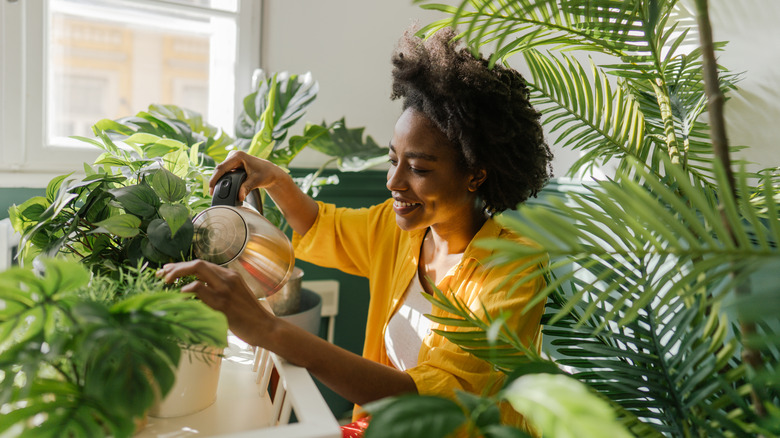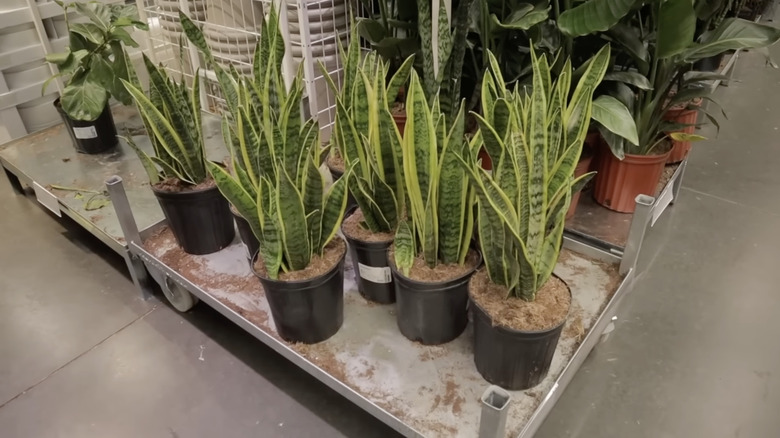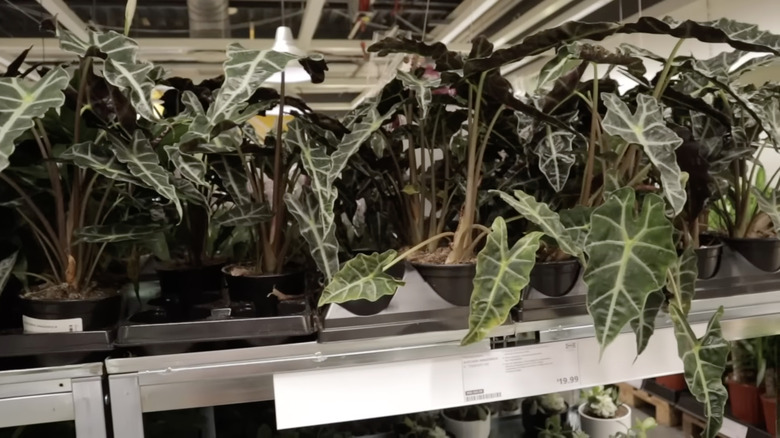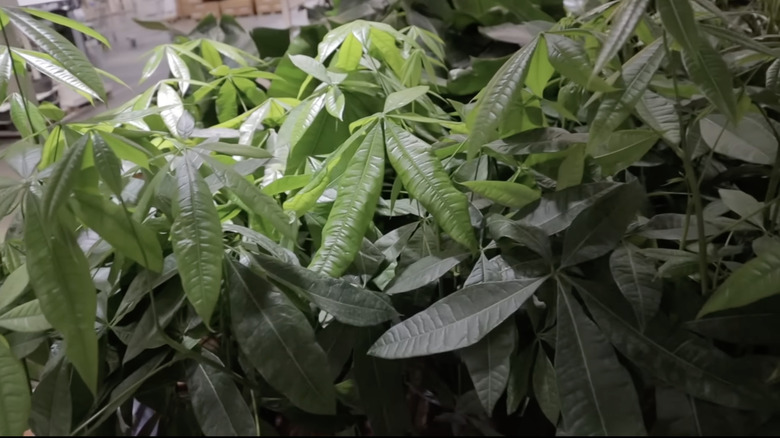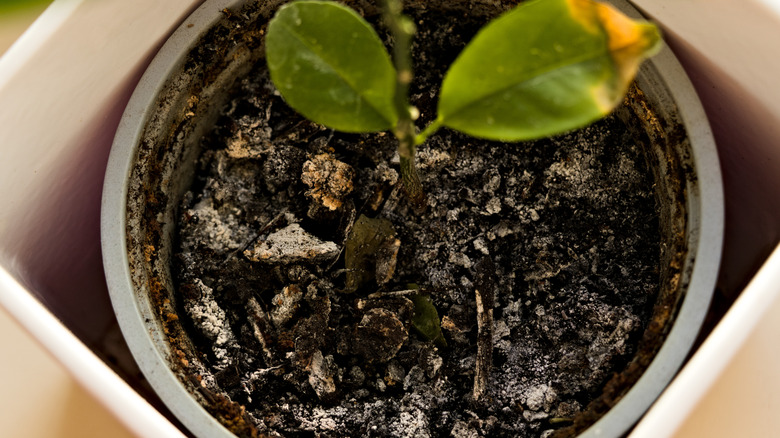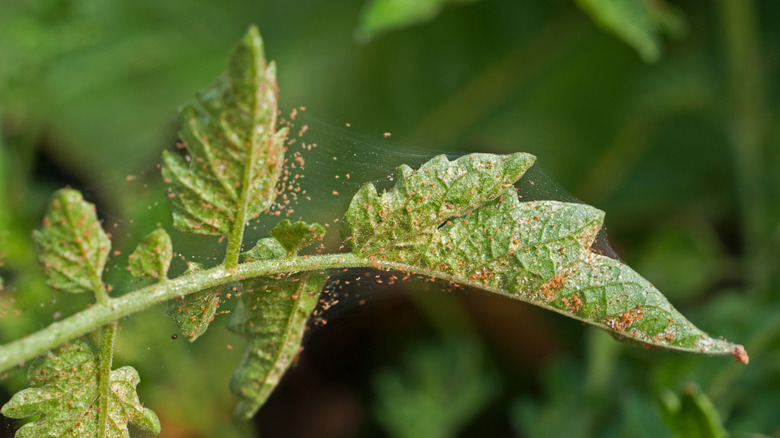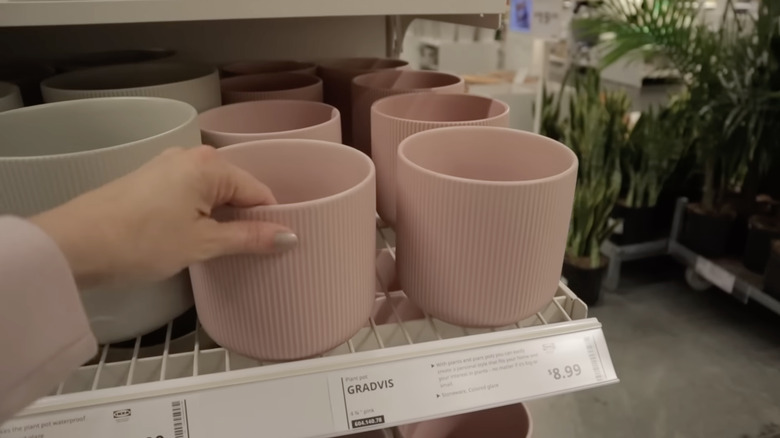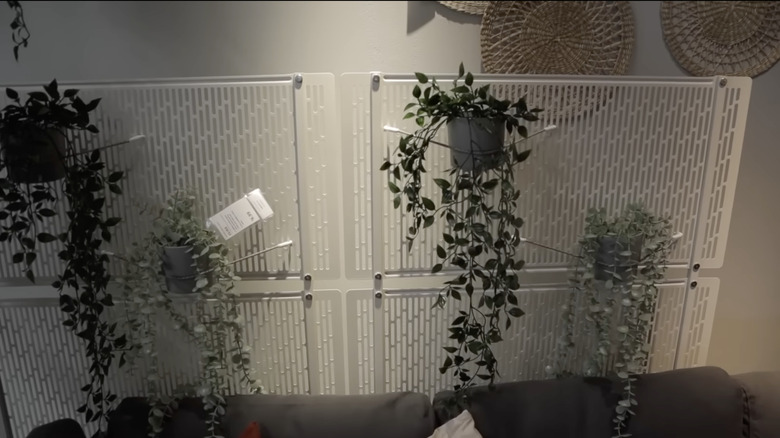The Ultimate Guide To Buying Plants From IKEA
When you think about buying plants, IKEA probably doesn't make the top of your list. After all, IKEA is first known for its furniture and then its meatballs; plants seldom make the list. This is a huge oversight, however, as it may actually be a hidden gem for plant lovers. However, before you race to load up your virtual cart with new succulents, just know that while you can view a lot of the plants that it carries through its online store, you can't actually buy them online. You'll have to go down in person to get your greenery, but the advantage to this is knowing exactly what you're getting. Also try to remember that the store doesn't currently accept returns on their live plants, so be sure you're getting the one you want before you check out.
If you've been to IKEA before, you may be trying to remember if you passed through a nursery, and if you've never been, you may be unaware of how massive these departments usually are. Fear not; while IKEAs certainly aren't all laid out the same, you should usually be able to find their plant department toward the "end" of the store, near the checkout area or food court. This will often be right before the outdoor section and stock aisles. Once you've located it, here is what you need to know before buying one of their selections.
Make IKEA your first plant stop since it may have the best prices
When it comes to inexpensive, quality plants, IKEA comes up as one of the surprise favorites. That's because the average plant is less expensive than comparable stores — a snake plant costs $21.99 at Home Depot or $22.99 at Lowe's, but only $13.99 at IKEA. This certainly doesn't mean that these less expensive plants are of a lower quality, either. TikTok user @litlikkevic posted a video raving about the high quality of the plants she had recently purchased and urged others to visit the store for greenery.
While IKEA may not have the broad range of plants that a store with a garden center would, they still have an impressive catalog, with nearly 50 listed online — which, while you cannot order for delivery, can be ordered via the site's storefront for pickup. These don't just include small plants that you might see inside a grocery store. There are larger plants to pick from, such as a 45-inch palm or a 39-inch money tree. And before you ask, don't worry — they carry succulents and cacti as well.
You'll need to pop by once a quarter
IKEA gets in new plants four times a year, once in each new season. These new plants can include things like spring orchids or holiday-themed blooms, so if you've been through IKEA's plant department already and are looking to expand your at-home nursery, remember to check back for seasonal items.
If you're looking for something seasonal in particular, call ahead to the store you intend to visit, and they should be able to tell you if they have it in stock. They typically restock in February, April, August, and October, so if you go at the beginning of those months, you should be able to choose the healthiest versions of those plants. You can also call ahead to confirm when the shipment will be available to peruse. Oh, and don't worry about missing out on the regular stock plants by going in one season versus another, as the regulars — such as succulents — will be there year-round.
Plan your IKEA plant trip for a Monday, if possible
Once you've figured out what season to shop for your plants, you'll need to narrow down your weekday. If you're looking for the freshest plants, you'll want to come in on Monday. IKEA replenishes its aisles after receiving a weekend delivery, so you'll have more options to choose from and higher quality plants to pick from overall. You can also call ahead to confirm if your particular location follows this schedule or if they have another restock day.
It's also worth noting that IKEA is known to buy from local nurseries, so when those over-the-weekend plants do hit the shelves, they haven't come from too far away, meaning that they're likely in better condition than plants at stores that get shipments from further locations. Of course, you'll need to do your due diligence and check for any signs of stress or wear, but you will get nursery-quality plants if you shop during the correct months and days of the week.
Don't worry too much about plant maintenance and shop by vibe
When buying any plant, it's smart to take a look at the label for care instructions to make sure you can handle the care requirements. You'll still want to do this, of course, but at IKEA, you can shelve worries about buying an overly fussy plant and instead focus on its aesthetic appeal. That's because these stores usually have a lot of foot traffic, plenty of people handling the wares, and very little natural light. If it's sold at IKEA, it can handle all three of those things, making it a hardy, easy-to-care-for plant that you can take home even if you don't have a green thumb.
For example, one of the store's staple plants is the Dracaena, and as long as you give it bright indirect sunlight and a deep drink of water once a week, it's wonderfully low maintenance. Other easy choices include cacti, pothos, and snake plants.
Inspect the plant before buying it to ensure it's the best of the bunch
Once you decide on which varieties you want, there are a few things you should look at to make sure you're choosing the healthiest plants. This ensures you end up with a pretty and vibrant plant that will be in tip-top health.
First, you should do a soil check. You don't want soil that's dry or chalky, so poke around until you find one with damp soil, as it will likely be in better health. However, avoid ones in overly wet pots, since water-logged dirt can eventually lead to root rot and disease. For flowering plants, you'll also want to try to find one that has buds instead of blooms. You can never tell if the plant is at the very end of its bloom, so choosing one with buds buys you more time. Finally, you should check your plant leaves for health. Leaves in good health won't hang, droop, or curl in on themselves, and there won't be any discoloration. Wilted leaves or brittle and dead leaves are not a good indicator of health.
If possible, find a plant with pups to get more bang for your buck
A pup is an offshoot of the main plant. If you look into the soil and see more than one outcropping, you're in luck! Pups grow from the same roots as the parent plant at first, but will develop their own and can later be separated from the main plant and repotted on their own.
YouTube user Free Plants Forever found that this is a great way to get more bang for your buck in the IKEA plants section. If you find a plant with pups, you can essentially make your own two-for-the-price-of-one deal. They noted that many of the snake plants in IKEA have more than one plant in the pot, in both the adult and starter-stage plants. Ideally, you should wait until spring to repot pups since that's their growing season. They may lag a little bit after being replanted, but with plenty of sunshine and care, they should flourish before too long.
Be certain to check your final selection for spider-mites and pests
A plant lover's worst nightmare isn't just buying a host of new plants that will die, but unwittingly harming their entire plant collection for an infestation. Bringing home pests such as spider mites is a quick way to turn that nightmare into a reality. So before you unknowingly bring any bugs home, do an in-store check to be sure you're not about to infest your home.
Spider mites are one of the most common bugs you can bring home from a big box store or nursery. They are minuscule and hard to detect with the naked eye, but there are a few warning signs to watch for. A plant infested with mites might look spotty, sometimes in a yellow or off-white color, or even a brown or black. Check on the undersides of the plant leaves for mites, which will appear as speckles, and keep an eye out for webbing. If you're not sure if what you're seeing are mites, try shaking the leaf onto a flat, white surface; mites will fall off and scatter around. If you see any movement, the plant shouldn't be coming home with you.
Find the perfect planters and gardening equipment while you're there
If you intend to decorate your home with plants, you likely won't want to leave them in the plastic containers they come in. Usually, buying a handful of plants can be incredibly expensive by itself, never mind getting all the equipment and pots while you're at it. However, along with their exceptionally reasonable plant prices, IKEA also sells inexpensive pots and equipment.
For example, IKEA has a terracotta pot and saucer for only $7.99 or a beautiful steel hanging planter for $11.99. The store has more than just pots to offer, too; they carry watering cans, trellises with planters, plant stands, hangers and holders, and misters, truly making it your one-stop shop for indoor gardening. This allows you to get the bulk of your indoor garden supplies in one go, and at a much more affordable price than competitors.
If you don't find the plant you want, try the next nearest IKEA store
IKEA stock slightly varies from store to store, so if you don't find what you want at your first store, try the next nearest. Since IKEA sources its plants from local sellers when it is able, each store may have a slightly different stock to choose from. Some trendy plants might also be sold out in some and not others, so it's worth calling ahead to ask if a nearby location has the one you're trying to hunt down.
It's also worth noting that no matter the stock or condition of IKEA's live plants, you can always fall back on artificial ones if they don't have exactly what you're looking for, or if growing conditions in the room you intend to decorate are not ideal. IKEA has a great selection of tastefully realistic artificial plants, such as the top-selling FEJKA; a lovely hanging eucalyptus that looks shockingly lifelike.
